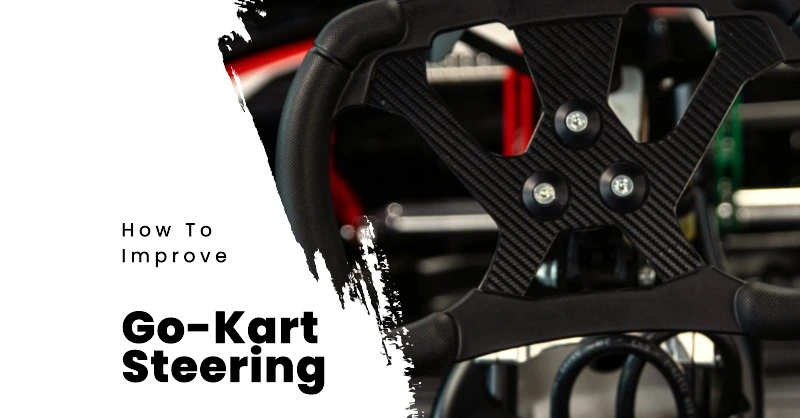Go-karting is an exhilarating sport that has captivated the hearts of racing enthusiasts for decades. One of the critical factors determining your success on the track is your go-kart’s steering performance. In this article, we will dive into the intricacies of go-kart steering and share expert tips to improve your steering skills and upgrade your go-kart for enhanced performance.
Understanding Go-Kart Steering Mechanisms
Before improving your go-kart steering, we must understand the mechanisms involved. Go-kart steering comprises Ackermann steering geometry, steering wheel and column, tie rods, and spindles. These components work in tandem to ensure smooth and efficient steering.
Tips for Improving Steering Control
Proper Kart Setup
- Alignment: Proper wheel alignment is critical to optimal steering control. Misaligned wheels can cause uneven tire wear, reduced grip, and decreased cornering performance.
- Camber and Caster: Adjusting your kart’s camber and caster can improve your steering response and stability. Camber refers to the angle of the wheels relative to the ground, while caster affects the steering wheel’s self-centering tendency. Experiment with different camber and caster settings to find the perfect balance for your driving style and track conditions.
- Steering Geometry Adjustments: Fine-tuning your go-kart’s Ackermann steering geometry can significantly impact its handling. Adjusting the tie rods and spindles can help minimize tire scrub and improve steering response, ensuring optimal performance during cornering.
Correct Steering Technique
- Hand Positioning: Proper hand positioning on the steering wheel allows you to make smooth, precise steering inputs. Hold the steering wheel at the 9 o’clock and 3 o’clock positions, using your fingers (not your palms) to grip the wheel firmly but gently. This position provides optimal control and flexibility.
- Smooth Steering Input: Applying smooth steering input is crucial for maintaining traction and preventing oversteer or understeer. Avoid jerky movements that can unsettle your kart’s balance.
- Avoiding Oversteer and Understeer: Oversteer occurs when the rear wheels lose traction, causing the kart to turn more than desired. Understeer happens when the front wheels lose grip, turning the kart less than intended. Both scenarios can be mitigated using proper throttle control, steering input, and mastering cornering techniques.
Steering Component Maintenance and Upgrades
Regular Inspection and Maintenance
- Checking for Wear and Tear: Regularly inspect your go-kart’s steering components for signs of wear and tear. Replace worn or damaged parts immediately to prevent further damage and maintain optimal steering performance.
- Lubricating Moving Parts: Proper lubrication ensures smooth operation and extends the lifespan of your steering components. Apply a suitable lubricant to all moving parts, such as tie rod ends and spindles, as part of your routine go-kart maintenance.
- Ensuring Proper Tightness of Components: Loose or improperly tightened steering components can cause steering issues and pose safety risks. Regularly check and tighten all connections, ensuring they are secure but not over-tightened.
Upgrading Steering Components
- High-Quality Steering Wheel: Investing in a high-quality steering wheel can improve your steering control and feedback, enhancing your overall driving experience.
- Performance Tie Rods and Spindles: Upgrading to performance-oriented tie rods and spindles can help optimize your kart’s steering geometry and improve overall handling.
- Quick-Release Steering Hub: A quick-release steering hub lets you remove and reattach your steering wheel easily, improving convenience and safety during pit stops and maintenance sessions.
- Steering Dampers: Installing steering dampers can help reduce vibrations, improve steering feedback, and enhance overall stability during high-speed runs and challenging track conditions.
Related Article: How Does Go-Kart Steering Work?
Conclusion
Improving your go-kart’s steering involves a combination of proper kart setup, correct steering technique, and regular maintenance and upgrades of your steering components. By following these expert tips and tricks, you’ll be well on your way to becoming a more skilled and confident go-kart driver. So, buckle up, hit the track, and enjoy the thrilling world of go-kart racing!
Frequently Asked Questions
You can adjust the caster angle, toe angle, or tire pressure to make go-kart steering less sensitive. Increasing the caster angle will make the steering less sensitive, pushing the wheels toward the vehicle’s centerline. Adjusting the toe angle can also make the steering less sensitive, as it changes the angle of the wheels concerning each other. Finally, reducing the tire pressure can also make the steering less sensitive, making the tires more pliable and less likely to respond to every slight movement of the steering wheel.
To fix an understeer on a go-kart, you can adjust the weight balance, the tire pressure, or the camber angle. Understeer occurs when the front wheels lose grip, causing the kart to push wide in turns. Adjusting the weight balance by moving the weight towards the kart’s rear can help transfer more weight to the front wheels, improving grip. Adjusting the tire pressure can also improve grip, as can adjusting the camber angle to increase the contact patch of the front tires.
You can adjust the caster or toe angle to make your steering more responsive. Decreasing the caster angle will make the steering more responsive, allowing the wheels to turn more easily. Adjusting the toe angle can also make the steering more responsive, as it changes the angle of the wheels about each other, giving them more or less grip depending on the desired responsiveness.
To achieve smooth steering control, you can adjust the steering ratio, install power steering or reduce any looseness in the steering components. The steering ratio refers to the angle at which the steering wheel must be turned to achieve a certain angle of the wheels. A higher steering ratio will enable smoother movements of the steering wheel. Power steering will also reduce any jerks or sudden movements while steering. In addition, check for any looseness in the steering components and tighten any loose bolts, mounts, or connectors.
Various factors, including mismatched tire pressure, improper weight balance, or incorrect alignment angles, can cause excessive understeer. When tire pressure is unequal, it is more likely that one of the tires will lose traction, which could cause excessive understeer. An incorrect weight balance can also cause excessive understeer as it affects the grip of the vehicle’s wheels. The alignment angle of the wheels also plays a crucial role in how much understeer is experienced. Too much negative camber angle or uneven toe angle on the front wheels can significantly cause understeer.

Goran, an experienced go-kart racer, fuels GoKartLife.com with his passion and expertise. He offers valuable insights and tips for fellow enthusiasts, fostering the growth of the go-kart community. Join Goran at GoKartLife.com and immerse yourself in this exhilarating sport.
Last modified: February 16, 2025



